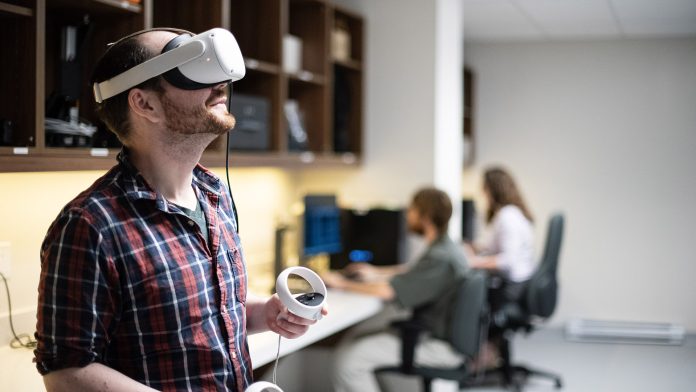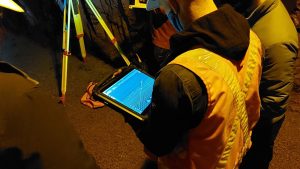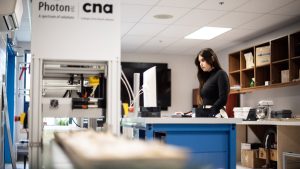College of the North Atlantic (CNA) is committed to integrating sustainability into its academic environment and promoting cutting-edge green technologies and research.
College of the North Atlantic is at the forefront of sustainable development in Newfoundland and Labrador, leading the charge with cutting-edge green technologies and a new School for Sustainable Development. This bold initiative spans CNA’s 17 campuses, reinforcing its commitment to the green transition.
To delve deeper, The Innovation Platform spoke with Dr Gary Thompson, Dean of the School of Sustainable Development, and Dr Michael Long, Dean of Applied Research and Innovation.
What’s driving CNA’s Strategic Plan for Sustainable Development and Growth?
Dr Thompson: CNA’s 2023-2026 Strategic Plan is laser-focused on equity, diversity, inclusion, innovative teaching, and sustainable growth. We’re embedding sustainability into everything we do – from operations to curriculum – aligning with the UN’s Sustainable Development Goals (SDGs). This isn’t just about going green; it’s about equipping our students with the skills to thrive in a rapidly evolving, eco-conscious economy.
Opportunities abound in Newfoundland and Labrador, from wind energy to green construction. CNA is positioning itself as a leader in these sectors, offering a curriculum that prepares students for the booming green energy workforce.
As green energy technologies develop, there is a strong demand for skilled workers who possess the knowledge and expertise required in the sector. CNA is poised to develop expertise in this sector to support local employment opportunities for the residents of Newfoundland and Labrador. Sustainability will further diversify CNA’s curriculum, educational programming, and operations in the coming years.
Can you tell us about the new School of Sustainable Development?
Dr Thompson: The School of Sustainable Development is already in full swing, launching programmes that tackle climate change and green building. We’re partnering with industry and government to address Atlantic Canada’s green labour needs. Here’s how we’re making an impact:
- Curriculum Development: New programmes are focused on sustainable practices and green tech, and existing courses are being revamped to include sustainability principles.
- Community Engagement: We’re working hand-in-hand with local communities to promote sustainability projects, educating and engaging the broader public.
- Campus Operations: From reducing energy use to ramping up recycling, we’re making our campuses greener. Think campus-wide sustainability challenges and green certifications.
- Workforce Development: We’re prepping students for green careers with training programmes and certifications in renewable energy and sustainable resource management.
This approach ensures CNA graduates are not just knowledgeable but passionate about driving positive environmental change. Our sustainable operations are setting a new standard for institutions everywhere.
What new programmes does the School of Sustainable Development offer?
Dr Thompson: In 2023, we launched two key programmes: A one-year Wind Turbine Technician certificate and a two-year Hydrogen Technician diploma –the first of its kind in Canada. These programmes are designed to meet the demands of the renewable energy sector, providing hands-on experience and critical theoretical knowledge. Our first Wind Turbine Technician cohort graduated in June 2024, and they’re already in high demand. We’re also gearing up to launch a new solar programme in 2025, further solidifying our commitment to innovation and environmental stewardship.
This plan is not the first example of CNA’s commitment to sustainability and cutting-edge technologies. How is the Office of Applied Research and Innovation (OARI) advancing sustainability?
Dr Long: At OARI, technology is one tool in the matrix of sustainability. We’re using advanced technologies like LiDAR (Light Detection and Ranging) and 3D modelling to give businesses and communities detailed, accurate representations of their environments and operations. This helps them to do things better, lighter, cheaper, faster or smarter.
How does collaboration fuel innovation at CNA?
Dr Long: Collaboration is at the core of our work. We don’t start research without a partner who has a specific challenge, problem, or bottleneck that needs addressing. This means constant outreach and site visits to understand their needs. We also love showing potential partners our labs and projects to demonstrate how we can make a real impact together.
How is CNA equipped to facilitate cutting-edge research?
Dr Long: Applied research is a complex undertaking requiring many systems. Most people think about technology or labs when they think about research, but the truth is your team is the core. That team is comprised of researchers, technologists, technicians, interns, students, faculty, and administrative personnel – the full gamut.
CNA and its 17 campuses are also key. Having such proximity to rural businesses and communities is incredibly important to support innovation services.
What is the Reality Capture and Digitisation Access Centre (RCD TAC)?
Dr Long: The RCD TAC is our latest innovation hub, one of 64 specialised applied research centres in Canada. We use cutting-edge reality capture technology – like handheld LiDAR and aerial photogrammetry – to create 3D models that are transforming industries.
In mining, we don’t just map the precise location of minerals; we redefine the possibilities of resource extraction with unparalleled accuracy. Our expert team has also helped them monitor ventilation underground. We’ve even revitalised abandoned mines by updating their physical and mineralogical maps.
In the construction sector, our 3D models are game changers. They guarantee precise measurements and integrate with industry-standard software like CAD and GIS. Our clients say even their cost estimates are now more accurate.
Our clients in the automotive and aerospace industries leverage our cutting-edge models to simplify complex processes, enhancing precision and productivity.
Heritage preservation is another area where we shine. We’re creating a comprehensive digital database of historic properties throughout Newfoundland and Labrador. Our detailed 3D models capture every architectural nuance, ensuring these treasures are preserved and maintained for future generations.
Our centre was deeply honoured to contribute to the commemoration of Newfoundland and Labrador’s sacrifice during the First World War. Our 3D model played a significant role in the completion of the final statue of the Trail of the Caribou in Gallipoli, Turkey.
These achievements are just the beginning. Our goal is to make advanced tech accessible to all businesses, level the playing field, and drive innovation across the board.
Can you elaborate on some of the technologies on offer at RCD TAC and provide some examples of successes facilitated by the Centre?
Dr Long: One of the hallmarks of the suite of technologies at the RCD TAC is portability. This is how we bring technology out of the lab into real-world environments. Our teams are constantly in the field. Our reality capture technologies can be handheld, such as a metrology scanner, which can create a 3D model of an object down 0.025 of a millimetre in accuracy. We also like to use drones as vehicles to capture data in larger areas.
We have topo-bathymetric LIDAR systems that can give you a very accurate 3D model of both underwater and on land; we have hyperspectral systems that can see what the human eye cannot; we have autonomous LiDAR drones that literally fly themselves on data collection missions to help us model environments and structures; and there are robust inspection drones such as Elios 3 for harsher environments.
All these technologies are data collection engines that help us see our world better so we can plan and decide more accurately.
How does CNA plan to stay ahead in reality capture and digitisation?
Dr Long: Technology evolves rapidly, and we’re committed to staying at the forefront. This means linking technology to business needs, ensuring that every tool we invest in has a clear application that benefits our partners. With support from industry and government, we’re positioning ourselves to be major players in the wind and hydrogen sectors, all while advancing our sustainability goals.
What’s the long-term vision for the School of Sustainable Development?
Dr Thompson: Our vision is to make CNA the leader in sustainability education and innovation in Atlantic Canada. We’re expanding our curriculum to include new programmes in renewable energy, sustainable resource management, green building, and environmental conservation. Sustainability will be woven into every discipline, ensuring all graduates are well-versed in sustainable practices.
Beyond academics, we’re establishing research centres focused on green technologies and environmental protection. These will be innovation hubs where we partner with industry, government, and other institutions to tackle real-world sustainability challenges.
Community engagement is key. We’re working with local communities on sustainable projects and building global partnerships to share knowledge and best practices. On campus, we’re implementing green initiatives like energy efficiency and waste reduction, aiming to be a model for other institutions.
We’re also committed to workforce development, offering training and certifications in emerging green technologies. Our expanded career services will connect students with job opportunities in the green economy, both locally and internationally.
In the coming years, we’ll scale up our efforts with new degree programmes, increased research funding, and stronger community outreach. Our goal is to drive sustainable innovation and prepare the next generation of leaders in the green economy.
Through these strategic initiatives, the School of Sustainable Development at CNA aims to significantly enhance its impact, contributing to a more sustainable future by educating the next generation of leaders in the green economy and fostering innovation in sustainable practices.
Please note, this article will also appear in the 19th edition of our quarterly publication.












